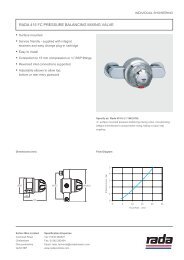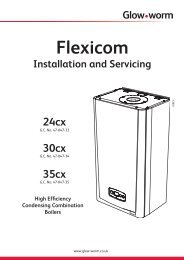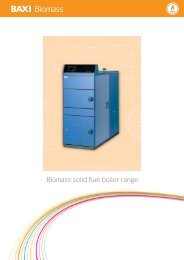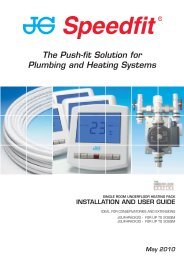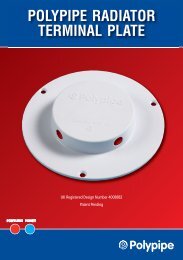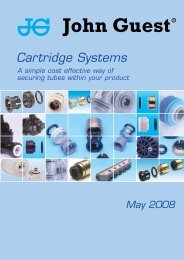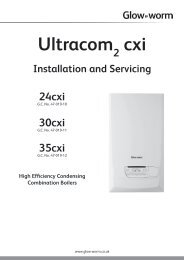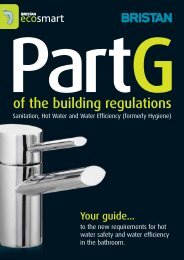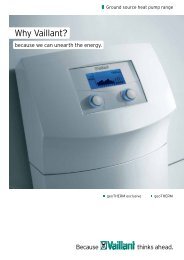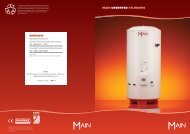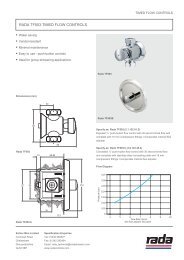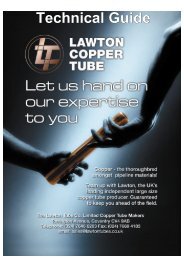Hep20 Technical Handbook
Hep20 Technical Handbook
Hep20 Technical Handbook
Create successful ePaper yourself
Turn your PDF publications into a flip-book with our unique Google optimized e-Paper software.
Hep 2<br />
O ® Performance Data<br />
Strength and Durability<br />
Pull-out resistance<br />
BS 7291: Part 2: 2001 provides a test<br />
procedure for assessing the pull-out<br />
strengths of pipes from fittings.<br />
Hep 2 O ® pipes and fittings have<br />
been tested and offer resistances in<br />
excess of these requirements.<br />
The levels required by BS 7291: 2001<br />
are shown in Table 1.<br />
Hydrostatic pressure resistance<br />
and life expectancy<br />
The ability of a pipe to resist water<br />
pressure depends upon the tensile<br />
strength of the material, which<br />
varies with temperature.<br />
Hep 2 O ® pipe has been tested to<br />
resist various pressures at various<br />
temperatures representing normal<br />
operating life cycles. Refer to Table 2.<br />
Hep 2 O ® pipes and fittings conform<br />
to the long term hydrostatic<br />
strength tests as detailed in BS 7291:<br />
Part 1: 2001, Clause 6.3.<br />
A life expectancy of not less than 50<br />
years can be extrapolated from this<br />
data, and is based on the range of<br />
intermittent flow temperatures that<br />
these systems would normally<br />
experience, ranging between 12 bar<br />
20ºC and 6 bar 90ºC.<br />
Short exposure to temperatures up<br />
to 100ºC resulting from<br />
thermostat/system malfunction will<br />
not cause failure, but may shorten<br />
the long term design life of the<br />
system.<br />
Effects of Fire<br />
Flammability and burning<br />
In common with most other organic<br />
polymers and materials used in the<br />
manufacturing and construction<br />
industries, polybutylene will burn. It<br />
is difficult to ignite, however, and is<br />
defined as combustible but not<br />
highly flammable.<br />
Fire protection<br />
Polybutylene pipe, less than 50mm in<br />
diameter, does not need to be<br />
sleeved in intumescent material when<br />
passing through a fire resistant wall.<br />
Table 1 BS 7291: 2001 Pull-Out Force Requirements<br />
Nominal outside pipe diameter<br />
*From BS 7291: Part 2: 2001,Table C1<br />
BS safe maximum pull-out force<br />
10mm 380N *<br />
15mm 705N *<br />
22mm 1190N *<br />
28mm 1960N *<br />
Table 2 Operating Temperatures and Pressures<br />
Peak life cycle operating<br />
temperatures<br />
Short malfunction<br />
20ºC 30ºC 40ºC 50ºC 60ºC 70ºC 80ºC 90ºC at 100ºC<br />
Safe pressures<br />
Bar 12 11.5 11 10.5 9 8 7 6 3.5<br />
psi 174 167 160 152 131 116 102 87 51<br />
Head of water (m) 120 115 110 105 90 80 70 60 35<br />
Thermal cycling<br />
Thermal cycling - the rise and fall in<br />
water temperature during normal<br />
operation - also induces different<br />
and additional stresses on pipes and<br />
joints.<br />
Hep 2 O ® conforms to the<br />
requirements of a thermal cycling<br />
test schedule, to prove the strengths<br />
of a plumbing system, as detailed in<br />
BS 7291: Part 1: 2001.The schedule<br />
is set out in Table 3.<br />
Table 3 Thermal Cycling<br />
Hot water Cold water Min pressure No. of cycles<br />
Inlet temp Duration Inlet temp Duration Bar psi m/head<br />
83 ± 2ºC 20 mins 15 ± 5ºC 10 mins 3.5 88.2 60 5000<br />
114 ± 2ºC 20 mins 15 ± 5ºC 10 mins 6 88.2 60 1000<br />
105 ± 2ºC 20 mins 15 ± 5ºC 10 mins 3.5 88.2 60 5000<br />
41



